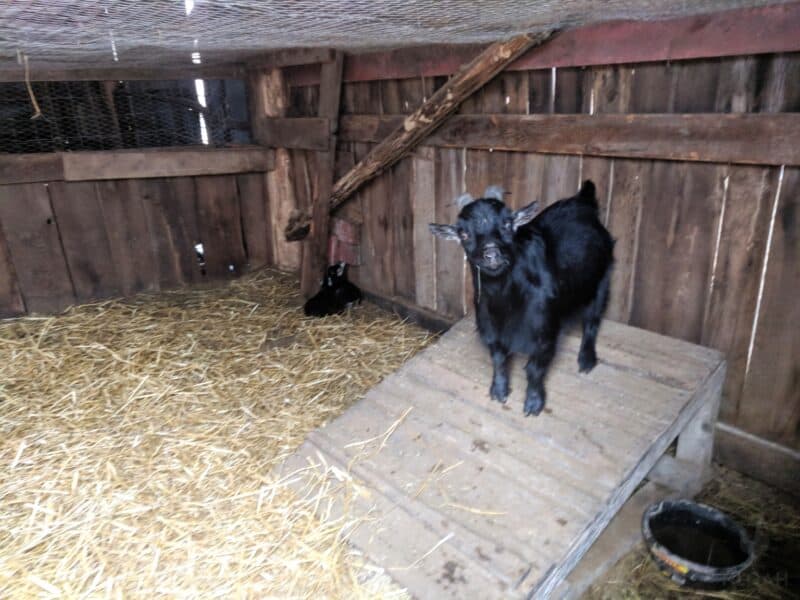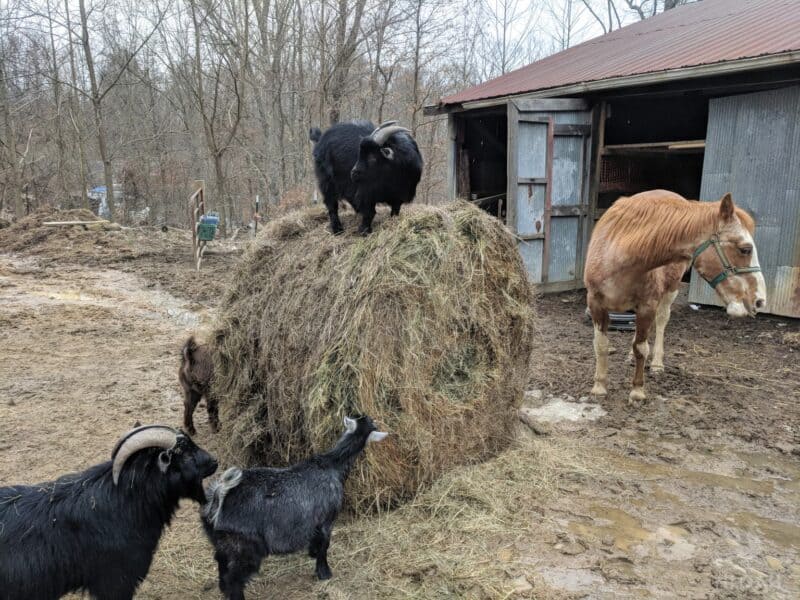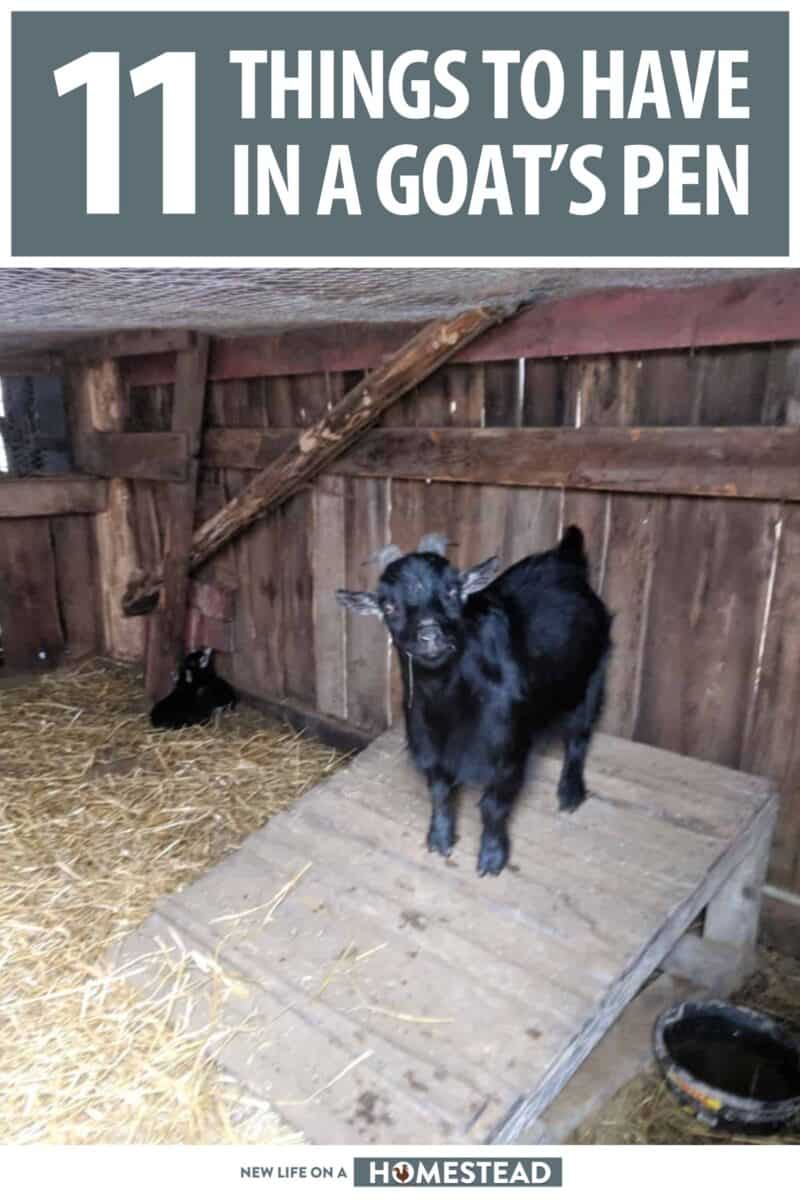Goats can be some of the most rewarding livestock animals to keep. They can also be some of the most frustrating!

They have peculiar diets, are prone to health issues compared to other animals and are legendary escape artists that are very hard on fencing.
For many goat keepers, rounding up escapees is a constant struggle.
However, you can keep your goats happier, safer and also increase the chances they will stay put by including a few special things in their pen.
I’ll be sharing with you 11 such inclusions that might make all the difference in the lives of your goats, and your own life! Keep reading and we will get right to it…
1. Fencing
Fencing is of course the single most important inclusion in any goat pen, and without it you don’t have a goat pen unless you are keeping them in a barn!
But keeping goats fenced in is often a whole lot harder than trying to do the same thing for other livestock species – even much larger species like cows and horses.
The reason is that goats are notoriously hard on fencing. They pull on it, they lean on it, they rack their horns on it, try to squeeze under it, and can easily jump over even tall fencing given a little boost.
This means that choosing the right kind of fencing for your goat pen is absolutely critical, and if you can afford it, a double row of fencing is often the best bet.
I prefer using woven wire livestock fencing or else electric fencing that will give goats a good jolt, good enough to quickly form a psychological barrier.
And, no matter what kind you choose, you must regularly inspect it for damage and weak spots. If you don’t find it before your goats do, they’ll be loose again!
2. Shelter
Shelter for goats is essential to assure their health, comfort, and safety. Structures with good air flow and protection from the elements are needed for them to thrive no matter what kind of climate they’re living in…
But the type of structure or shelter needed depends on your climate, the size of your herd, and if you’re raising them for milk or meat production.
In colder climates, insulated barns can offer much-needed protection against the harsh winter temperatures.
In warmer climates, a simple structure with a roof to protect from sun and good ventilation is often all you need to keep your goats happy and healthy.
Whatever your circumstances, you’ll definitely want the shelter to be inside the enclosure where your goats are kept…
First, your goats should be able to access it at any time when they want shelter, and second, any time you try to relocate your goats from the pen, there’s a chance they will jailbreak and go on the run!
Being able to enter the pen and then put them up when required gives you a lot more control.
3. Bedding
No matter the climate and no matter the shelter, goats need bedding. Bedding can be anything from straw to sawdust, and it should be changed regularly to keep the area clean and your animals healthy.
In colder climates, having a deep layer of bedding will also help keep your goats warm.
They don’t have thick fur coats like many other animals, and even the most hardy, cold-adapted goats are still relatively vulnerable to cold weather compared to other livestock species.
One more tip from me: Whatever kind of bedding you use, make sure it isn’t something that goats will eat, or be tempted to eat.
Straw is fine if goats have plenty of access to other, better foods and hay, since they won’t eat it in place of better foods, but if you put down some extra hay as bedding you won’t have bedding for long – the goats will eat it right up!
Eating soiled hay also increases the chances of health problems for your goats, so keep an eye out for that.
Speaking of health issues, avoid any bedding that is prone to raising dust since this is another common cause of respiratory issues for goats.
4. Milking Shed
Not required if you aren’t raising dairy goats, but if you are, this is a must-have. A milking shed is exactly what it sounds like: A separate, covered area where you can milk your goats in a clean environment, rain or shine.
The milking shed should have an area to restrain the goat for milking, give you room to work and keep the milking equipment and other necessary tools, such as strainers, buckets, and containers.
If it is lit and cozy, so much the better, since goats need to be milked no matter what when they’re in milk. It will also help to encourage goats to cooperate.
They are creatures of habit and respond very well to regular, pleasant routines, so having an atmosphere where they always get treats can help make milking easier as time goes on.
And, as you likely already thought, do make sure your milking shed closes up securely when not in use!
5. Kidding Pen
A kidding pen is something of a controversial topic among goat owners, but I’ve definitely come around on them myself…
A kidding pen is basically a small or pen that you can put heavily pregnant does in for the final wait of their pregnancy, to keep them safe and protected during this vulnerable time and also to give them a clean, safe and calm place to birth.
It should be out of direct sunlight, have plenty of fresh bedding, and be large enough for the doe to comfortably stand up and turn around in.
Having a separate area like this can give both you and your goats peace of mind: You won’t need to worry about keeping an extra-close eye on potentially over-active pregnant ladies and they will know there is a safe place where they can rest without being harassed by more rambunctious herd members!
Now, you don’t have to have a kidding pen; many folks get by just fine without them and the Lord knows goats have been having kids forever just fine on their own.
But since these goats are ours and we are in charge of their wellbeing, I think a kidding pen is mandatory inclusion if you plan on breeding your goats more than a handful of times…
6. Jungle Gym
I say jungle gym as a catch-all term for climbing equipment and other surfaces goats can use. It sounds light-hearted, whimsical even, but you had best believe goats love to climb, need to climb, and they will on whatever is at hand.
Better they climb on something designed and safe for the purpose…
This isn’t just an enrichment thing, though it is that, too: goats climb for exercise, mental and physical.
Goats that cannot climb enough, or high enough, tend to develop anxiety issues and will year for escape. Soon, they will act on those urges!
So try to provide your goats with at least one elevated surface, preferably two and even better if they are odd and irregular surfaces.
Stumps, logs, tire stacks, and other homemade structures are great but make sure they’re stable and secure no matter how you build them!

Goats also love to climb up hay bales or pallets; these can be a great way to save money while giving your goats the access they need.
And don’t discount big mounds of dirt, trees and other natural formations. As always, do take care to make any surface safe for your goats.
However, and this is big one, you absolutely must ensure that there is no way whatsoever a goat can use their jungle gym to hop over your gate or fence, or to “lily-pad” their way from one obstacle to the next to do the same.
If they can, they will! Never site your goat’s climbing surfaces near the fence line!
7. Toys
Believe it or not, goats love to play as much as any other mammal. Even when they are adults!
Accordingly, having some toys in their pen for them is a great way to keep them happy and engaged – and that means less likely to break out or misbehave! Their jungle gym is good, but other toys are even better.
Goats love all sorts of toys, from various balls or empty jugs and buckets to bat around to trampolines and more.
As for balls, you can even make your own with a few large scale rope monkey fists, or buy some made of rubber or plastic specifically for goats.
As for the trampolines, you can either make your own with some old tires and a bit of ingenuity, or even donate an old mini-trampoline for the purpose.
One thing I will highly recommend is to invest in a few “goat teasers”. These are basically food containers or other animal toys that hold or conceal treats, and will only dispense them periodically after goats interact with them for a while.
It isn’t cruel: in nature, goats tend to work very hard for their food sometimes, and an engaging gadget to encourage this persistence will help them thrive. Just don’t make them eat from them all the time, of course!
No matter what you decide on, just make sure whatever toys you provide are safe and secure.
No loose parts that could become choking hazards if chewed up, no sharp edges to cut them. Use common sense, and remember that simpler is almost always better.
8. Water Tub
You already knew this one was going to be on here. All animals need plenty of water, goats included.
In fact, if you have goats in confinement, it’s even more important as they will not have access to as much grass and other marginal sources of water.
Goats tend to prefer their water buckets deep so they don’t have to stoop as much to drink. I suggest wide, large stainless steel buckets and tubs; these last longest, plus goats have a harder time figuring out how to tip them over when full.
I also advise having multiple water containers available at all times. Goats are very sociable creatures and like being around one another when drinking, but with only one source there can be disputes and sometimes it is best to alleviate pressure on vital resources even when in captivity.
As expected, this is one thing in the pen that will need regular cleaning!
9. Feeder
Your goats will need food pretty much all the time, and though you can let them simply eat off of the ground, your goats will be happier and healthier if you provide a proper feeder.
I suggest using hay racks and large scale mangers, as these are far cleaner and more controlled than feeding from the ground; plus, you can get ones that can easily be removed for cleaning or refilling.
These feeding stations also help limit waste; goats will trample and ruin some of their food when eating from the ground, but with a rack or manger, they are forced to eat nearly all of it, dropping only a little.
And just like with water above, you’ll want multiple for anything but the smallest herd. That way, the goats will have more choice in their eating habits and everyone can get a fair share while cutting down on confrontation and squabbling.
But remember that every herd is different; if your goats all get along around one big feeder at mealtime, don’t try to fix what isn’t broken…
10. Guardian Animal
Goats fit squarely in the middle of the great livestock size hierarchy. While they may be too big, and neither are they too small, they are still plenty vulnerable against larger predators.
Kids are always vulnerable. If you have large predators in your area, such as coyotes, wolves or bears, it’s highly advisable to have at least one guardian animal on hand.
When it comes to guardians, you have more options than you think. Dogs make great guardians as always, especially when trained.
They can quickly detect predators, and will easily run off or at least stall the attack of coyotes and wolves so you can intervene.
Alpacas or llamas also fit this bill nicely; you can even leave them in with the goats at all times as they tend to get along.
If using a dog, a double row fence might just be ideal as you’ll be able to let the dog roam in between the two fences if you provide a dog house, and this will give your goats some relief while allowing the dog to get predators before they get your goats.
11. Windbreak
One last thing, and I put it last because it isn’t applicable to all locations. If you live in a windy area, a windbreak of some kind is highly recommended for your goats’ comfort, as well as their health.
Even in a temperate or warm climates, constant exposure to high winds will stress goats and lead to issues, and may easily cause hypothermia when temps drop or if they get wet.
They might not want to coop up in their shelter, but they may want to huddle out of the wind.
A few strategic trees or hedges, a large mound of dirt, or even a purpose build wall section might be all you need to get your goats out of the wind and feeling secure.

Tom has lived and worked on farms and homesteads from the Carolinas to Kentucky and beyond. He is passionate about helping people prepare for tough times by embracing lifestyles of self-sufficiency.
